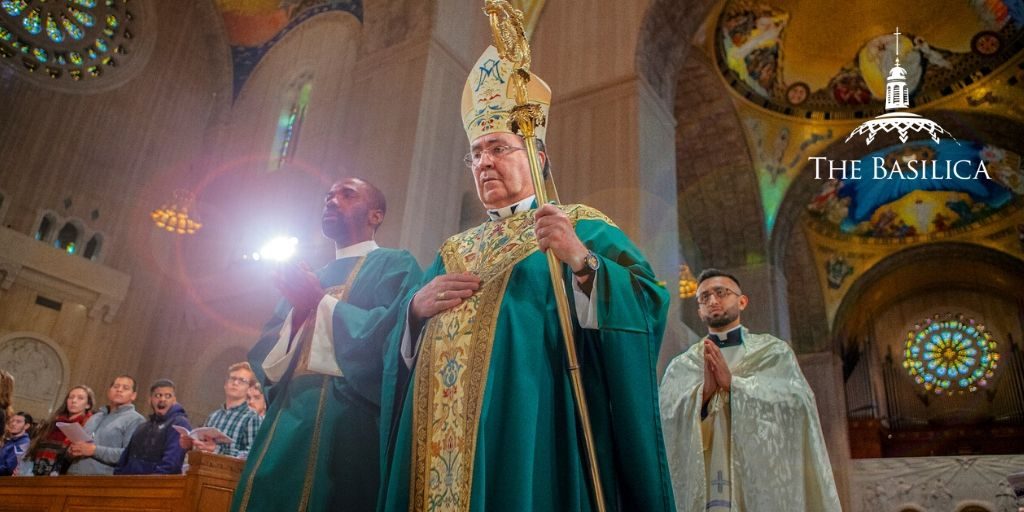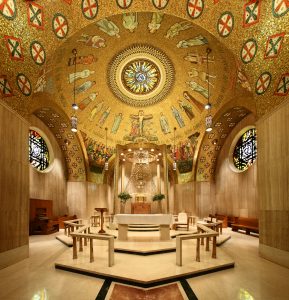

At Mary’s Shrine, pilgrims and visitors can encounter Christ through His Blessed Mother, the Word, the Sacraments, and Devotions. What goes into planning and preparing for over 2,500 Masses held each year at the Basilica? Take a glimpse into the roles of two individuals who are vital to the daily operations of the liturgy at the Basilica: Joe Basalla (full-time) and Victor David (part-time). As liturgy assistants, they manage the scheduling of the priests for Masses and Confessions, as well as over 300 liturgical volunteers that serve as Extraordinary Ministers of Holy Communion, Lectors, and altar servers. In part two of a two-part interview, they share why they believe the Basilica is a special place, and how working here has shaped their faith.
This post is Part II in a series. View Part I.
How has working at the Basilica impacted your own faith?
Joe: I always tell people that working at the Basilica, though challenging at times, is such a gift to my spiritual life. Not only do I get to help coordinate the liturgy here, I get to interact with pilgrims from all over the world who come here.
The people’s dedication and devotion to Christ and His Blessed Mother always give me the inspiration to keep pressing forward in my own spiritual life – coupled with the opportunity for Mass, Confession, Adoration and moments of quiet prayer. The Basilica is where I have found a spiritual home.
Victor: Since I came to Washington, D.C. nearly a decade ago, the Basilica has been an anchor which has enabled me to grow and mature in my faith. Attending and serving Mass, walking under the beautiful mosaics, and praying in the many chapels and oratories dedicated to the Blessed Mother have brought me great peace and comfort over the years. Working at the Shrine has only given me a deeper appreciation for what happened behind the scenes that allowed me to have those moments of growth and peace. To now have the opportunity to provide that for the many pilgrims who come to the Basilica is a true honor.

What are some of the most rewarding aspects of your work at the Basilica?
J: The most rewarding thing for me is knowing that as a result of what I do, hundreds of people will be able to have a living encounter with Jesus Christ. Christ calls all of us to be His hands in the world, and Christ has led me here to the Basilica to live out that call.
If I ever get too stressed about the day-to-day administrative work for the liturgy office, I go visit the Blessed Sacrament Chapel and simply say “Lord, never let me forget that all of this is for You.”
V: At many of our larger Masses, we usually have people who have come to the Shrine for a special occasion. One of the greatest compliments I have received was from someone who thanked me and the other servers for a job well done because it allowed her to pray. So often we can be distracted by other things during Mass, but for just a moment, we were able to provide an atmosphere that let her put all those worries aside and truly connect with the Lord.
Do you have a favorite place or piece of artwork at the Basilica?

J: My favorite chapel is the Miraculous Medal Chapel in the Upper Church. I love the gold altarpiece with a large depiction of the Miraculous Medal against the deep blue mosaic wall. Mary’s outstretched hands on the medal remind me of her role as Mother to us and her great power as an intercessor.
V: One of my favorite places in the Basilica is the Blessed Sacrament Chapel, just off the sanctuary of the Upper Church. There is an inscription on the altar that reads, “Food of angels, food for men – All you lowly come and eat.” St. John Paul II stated, “The Eucharist is the source and summit of the Christian life,” and I think the chapel truly reinforces that sentiment. Above the tabernacle is a canopy with pieces of gold seemingly falling from the ceiling. It is a perfect reminder that when we receive Communion, we are consuming heavenly food, the presence of Christ himself.
What do you think draws people to the Basilica?
J: I think people come to the Shrine for many initial reasons. Some come to be pilgrims and pray with us, others come to hear our music, to see our art and architecture, or to experience our liturgy. Regardless, I firmly believe that God inspired them to come here. I know many people who have come for non-religious reasons to the Shrine, including coming to see our Christmas decorations, and have, in some way, left different than when they came. This experience is different for everyone, but surely no one can come here and not feel God’s presence with them.
V: I think that most people search for the person or place that brings them happiness and peace. The Shrine can provide both: the presence of the Lord in the Eucharist, and a sacred space where people can freely pray and contemplate the divine.

What is your hope for those who visit the Basilica and/or attend Mass?
J: My hope for those who visit us, whether for the first or for the hundredth visit, is that they have an encounter with the living God here. All that we do here—our tours, our Masses and Confessions, our music—is aimed at bringing our pilgrims closer to God. My hope is also that our pilgrims will grow in their love for Mary, our Blessed Mother, and that they will ask for her help as we all continue our earthly pilgrimage.
V: I hope all those who come to visit and/or attend Mass at the Basilica leave with a sense of awe in what they have just experienced. I also hope they find a newfound appreciation for the Blessed Mother as a model of faith and a guide to her son.

